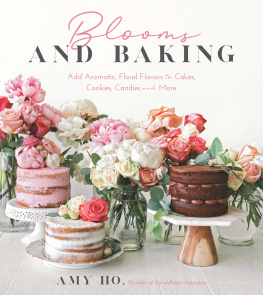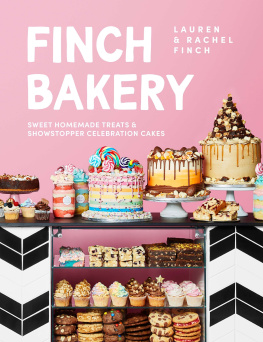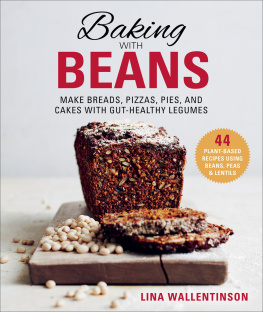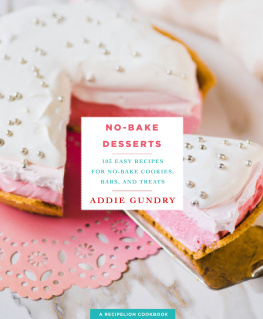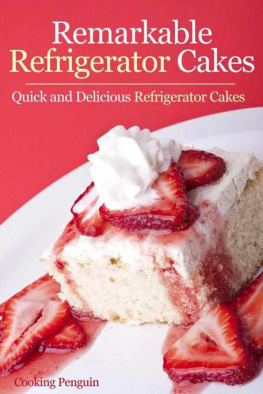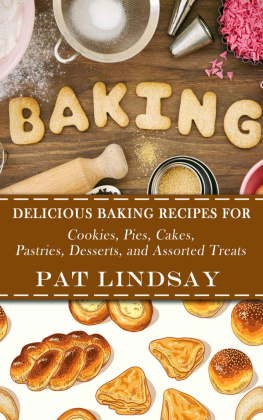Contents
Guide
BLOOMS AND BAKING
Add Aromatic, Floral Flavors to Cakes, Cookies, Candies and More
AMY HO, Founder of Constellation Inspiration
The author and publisher have provided this e-book to you for your personal use only. You may not make this e-book publicly available in any way. Copyright infringement is against the law. If you believe the copy of this e-book you are reading infringes on the authors copyright, please notify the publisher at: http://us.macmillanusa.com/piracy.
To my parents, for providing the love that allowed me to blossom.
To Rich, for filling my heart with the most beautiful blooms.
Falling in love with flowers is one of the quickest ways I fall in love. I love every diaphanous petal but also each imperfection a bloom might carry. Of the many things I wish lasted a while longer, flowers are one of the things I wish lasted forever. And this is why I love baking and decorating with flowers. Putting flowers on a cake makes the blossoms last longer because I get extra keepsakesthe best one being the experience of making and decorating the cake. Adding floral flavors to baked goods means I get to easily share this love of flowers with others too.
In this book, you will find treats that are perfect for baking on a weeknight and eating alongside your morning cup of coffee the next day (if you can wait that long). Some of the baked goods, like the layer cakes, are more of a weekend affairthey might be a bit over the top for everyday purposes, but I wholeheartedly believe that every day is worthy of a celebration with cake.
This book is divided into two main parts: baking with flowers and decorating with flowers. The former is a collection of recipes for cakes, cookies, choux, pies, tarts, and candies. These recipes are little love letters dedicated to all things delicate and sweet. They are inspired by seasonal flavors and florals and by places I have been and flavors that have lingered since. While baking and recipes are grounded in science (delicious science) and a precise understanding of how ingredients work together, decorating is the opposite. Cake decorating, especially with flowers, is my favorite art form. Whether I am decorating with fresh flowers or piping intricate petals, I believe any cake is more beautiful when adorned with flowers. Ultimately, this book is a collection of recipes, stories, and love letters that are sweet to read and even sweeter to eat.
Every flower is beautiful, but not every flower is edible. Many flowers are safe for consumption, but we will be focusing on edible flowers that you can easily find in stores or purchase online. There are multiple ways to add floral flavors to your baked goods: folding the (usually dried) flowers themselves into the batter before baking, incorporating flowers into the filling, turning flowers into floral syrups to infuse into baked goods, and adding flowers directly onto the pastry itself. Including flowers and floral flavors in your baked goods is easy but must be done carefully. Too much and your cake or buttercream can taste soapy or too perfume-like. With buttercreams, ice creams, and other sweets that I do not need to bake, I like to start with a smaller amount of floral flavoring and add more if the flavor is too faint. Tasting as you go is the best bet. This is harder for things like cake batter or cookie dough, but remember that less is always more.
A great way to incorporate floral flavors into baked goods, especially cake, is to use floral syrups. Floral syrups are helpful for getting flavors out of certain flowers when baking the flowers directly into the cake or incorporating them into the buttercream is not the best option. It is also a great way to preserve flavors of flowers that are highly seasonal. For example, elderflowers only bloom for a short period during springtime, but when made into a syrup, elderflower flavor can be incorporated in a variety of baked goods throughout the year. Many floral syrups can also be bought in stores. A gentle brushing of floral syrup on a cake layer is an easy and effective way to introduce floral flavor to the finished cake and to keep the cake extra moist. Syrups can also be added to buttercreams.
Floral syrups are extremely simple to make. You only need three ingredients: water, sugar, and the flower of your choice. (Sometimes lemon is added as well.) Generally, the ratio of water to sugar is 1:1that is, for 1 cup (240 ml) of water, you want 1 cup (200 g) of granulated sugar. With 1 cup (240 ml) of water and 1 cup (200 g) of granulated sugar, I like to add these amounts for each respective flower to make the syrup (add more or less depending on your preference):
- Elderflower: cup (10 g) elderflowers; large lemon, thinly sliced; 1 tablespoon (15 ml) fresh lemon juice
- Lilac: 1 cup (15 g) fresh lilac buds (add cup [100 g] blueberries for a vibrant purple color)
- Jasmine: to cup (6 to 8 g) dried culinary-grade jasmine flowers
- Chamomile: 3 to 4 bags chamomile tea
- Rose: cup (5 g) dried culinary-grade rose petals
- Lavender: 1 to 2 teaspoons (1 to 2 g) dried culinary-grade lavender
In a small saucepan over medium heat, bring the water and sugar to a boil. Reduce the heat to low and simmer the mixture until the sugar is dissolved, about 3 minutes, stirring at each minute interval. Add the flowers and any add-ins, then simmer the syrup for 10 minutes. Remove the saucepan from the heat and pour the syrup through a filter or fine-mesh sieve into a sealable glass jar to remove the flowers. Let the syrup cool, and then put it in the refrigerator.
The syrups can be refrigerated in a glass jar for up to 1 month. If you need to store a syrup longer, it can also be frozen in an airtight container for up to a year. Note that syrups will not freeze solid due to the high sugar content.
I love flowers. I have always wished that fresh flowers would last longer than their short bloom time. To preserve the beautiful blooms and enjoy them year-round, I incorporate them into cakes and cupcakes. By adding finely ground dried flowers to cake batters and ganache, steeping flowers in milk for cake batter, and turning seasonal wildflowers into homemade floral syrups for buttercream and for brushing on baked cake layers, I am able to appreciate these flowers beyond their bloom time and original form. Fresh elderflower becomes elderflower syrup for .
For additional cake assembly tips beyond the ones provided in each recipe, please refer .

